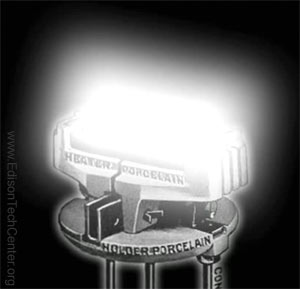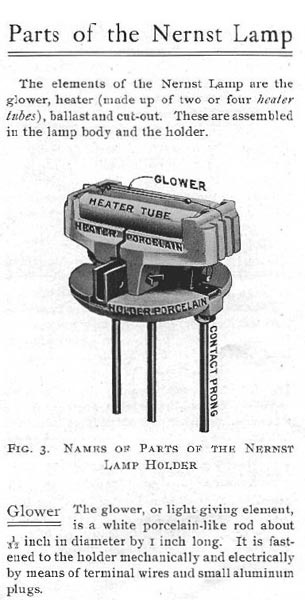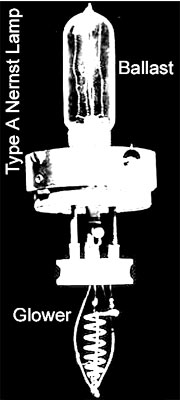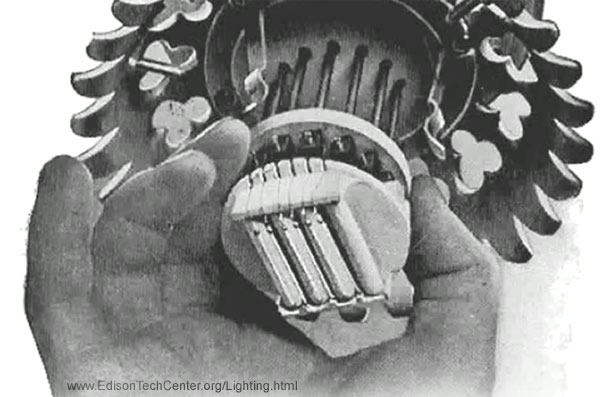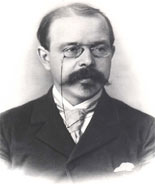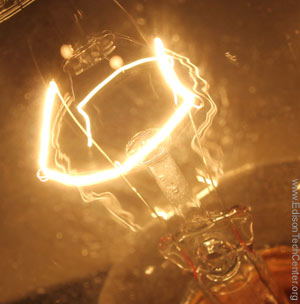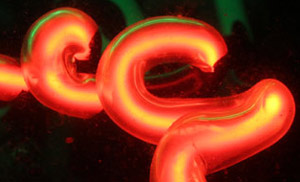Nernst LampA new form of incandescent light for homes and medical uses
History (1897 - 1980s)
Introduction & Statistics
The nernst lamp was invented as an improvement to the existing incandescent lamp. It lasted longer and had improved efficiency. The lamp became a serious competitor to standard bamboo and cellulose filament incandescent bulbs at the time. The nernst lamp was created by a physicist not an untrained tinker. This was actually an important trend of the 1890s. Simple trial and error methods used by Thomas Edison would not be able to create such a sophisticated device. The success of engineer/inventors equipped with the latest in scientific knowledge acquired in Germany and Switzerland sent a powerful message to the rest of the world that we are in a new age of technology. Because of market threat from the nernst lamps(Sold by Nernst in Europe and Westinghouse in US) and tantalum filament lamps (owned by Siemens & Halske), General Electric founded the GE Research Lab and hired people of every nationality to work together. Corporations knew they had to trust and invest in the 'new' breed of engineer to keep them afloat.
Statistics
*Lumens per watt: 6-9
*Lamp life: 450 - 1200 hours
*CRI 100
*Color Temperature ~3000
Common uses: indoor lighting, specific medical uses where infrared light is needed
This light is now obsolete. Nernst lamp heyday was 1900 - 1913. They are no longer produced.
1. How They Work 2. Inventors and Developments
Nernst Lamp uses a small ceramic rod that was heated to incandescence. The lamp is also called a incandescent "glower". Ceramic does not oxidize like metal, so it did not need to be enclosed in a bulb.
Our video about the nernst lamp is the best way to understand how it works.
First the heater tubes would rise in temperature to the point of a soft red glow. This would prepare the glower. When the glower reached a certain temperature the resistivity dropped to the point where current would begin to flow through it. At this point a shifter or switch would stop providing power to the heater tubes and all current would flow through the glower (see the video of the schematic below). The glower created a nice pure white light similar to a halogen lamp today.
Longer Life:
The point of the bulb in regular incandescent lamps is to create a vacuum around the filament to prevent the filament from oxidizing which lengthens the life of the filament. In a nernst lamp the glower had a longer life than the incandescents of the time. The glower could be replaced, boxes of replacement glowers were sold. This was much more practical than replacing the whole lamp head unit (see the illustration left).The ballast is made of pure iron wire in a glass bulb filled with hydrogen gas (to prevent rust). It is a simple resistor.
Schematic of how the lamp works: (embedded Youtube video)
Type A Nernst Lamp:
coiled ceramic glower
Type C lamp. Westinghouse ended up buying the license to sell the lamp in North America. This illustration above shows a large nernst lamp with 6 glowers. This would allow the lamp to be placed on high ceiling interior locations where it could replace the already popular carbon arc lamp. This meant that the nernst lamp was competition for older small and large area lighting systems.
Walther Nernst
The Nernst Lamp was invented by Walther Nernst in Göttingen, Germany in 1897. This lamp emits a natural light, close to the daylight spectrum, unlike incandescent bulbs.
Nernst was born Briesen in West Prussia (close to the same region as Charles Steinmetz) and studied in Zurich, Berlin, Wuerzburg. He founds the Institute of Physical Chemistry and Electrochemistry at Göttingen in 1897. He worked on many other technologies and with a heavy background in science he helped steer engineering into a new age. He was a outspoken opponent of Nazism and Adolf Hitler, and as a result lost his job as a scientist and died poor in 1941.
*Nobel Laureate Irving Langmuir studied under Walther Nernst in Göttingen and helped him develop the Nernst lamp. Langmuir went on to work for GE and greatly improve the incandescent lamp. (see the Incandescent Lamp section above)
Continued Use Today:
The "Nernst Glower" was important for use in the medical field in infrared spectroscopy until the 1980s.
|
Previous: The Incandescent Lamp 1802 |
Next: Neon Lamps 1898 |
 |
|
Arc
- Incandescent - Nernst
- Neon - Mercury
Vapor - Sodium Lamp - Fluorescent
- Halogen - EL
- LED - MH
- Induction
|
COMMENTS?
Give us feedback
on this and other pages using our Facebook
Page
Back
to Home
Written
by M.Whelan with additional research by Rick DeLair
Please contact us if you are a historian and wish to correct or improve
this document.
Sources:
The Subdivision of the Light by Unknown
"A
History of Electric Light and Power" by B. Bowers
Westinghouse lamp catalogues from 1901-1903
Photos:
Edison Tech Center
Westinghouse
Photo/Video
use:
Commercial entities must pay for use of photos/graphics/videos in their
web pages/videos/publications
No one commercial or public is allow to alter Edison Tech Center photos/graphics/videos.
Educational Use: Students and teachers may use photos and videos
for school. Graphics and photos must retain the Edison Tech Center watermark
or captions and remain unmanipulated except for sizing.
Permissions
- Videos: We do not email, FTP, or send videos/graphics to anyone
except in DVD form. Payment is needed for this service. See our donate
page for pricing, and our catalogue
for a listing of videos on DVD.
Professional video production companies may get videos in data form with
signed license agreements and payment at commercial rates.
Copyright
2010 Edison Tech Center

